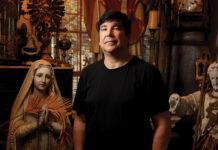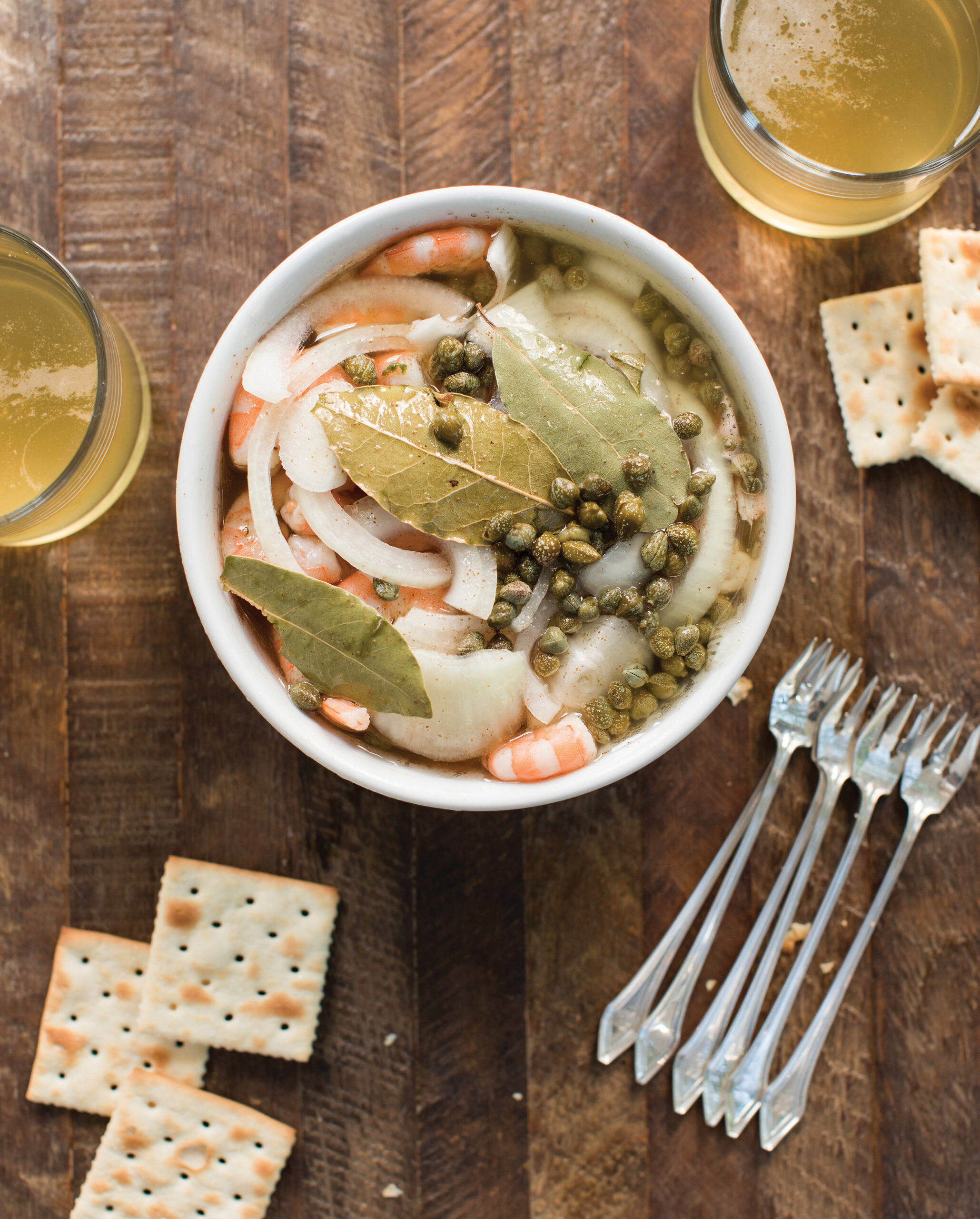


The Renaissance man from Common Street is anything but. Steve May is a Realtor, a craftsman, scholar, preservationist, designer, scavenger, storyteller, podcaster, researcher and mentor. He collects old bricks like they’re works of art, and he can tell the age of a house by the divots in its floorboards. He reads books about historic architecture for leisure. His world is made of salvaged ironwork, restored doorframes and unearthed stories. His work restoring Mobile’s blighted houses isn’t just architectural preservation for preservation’s sake. He sees it as his calling to help revive the soul of the city, one rescued structure at a time.
It’s hard to believe that Mobile’s historic home hero didn’t always know that he’d become the preservationist he is today. He didn’t even plan on living in the city, for that matter. “I was an Army brat,” he says. “My mom is from here, but my dad was a colonel in the military. We’d come here to visit family, but it’s not like living here. I thought it was too sleepy and Southern and small. Then I moved down here temporarily — what I thought was temporarily — in ’95, and I’ve been in Mobile for 30 years. It’ll do that to you. It pulls you in.”
His exposure to creaky floors and historic markers laid the foundation for his affection for old architecture. “I blame my mother for what I’m doing now,” he says. “As we moved around the country, she would drag two of my brothers and me to all these old houses and Civil War battlefields. I’ll never forget how she’d say, ‘Look, this place is only two inches away on the map.’ Three hours later, we’re in Appomattox.” That early exposure stayed with him when he arrived in the Port City. “I think I had an appreciation for architecture at a young age, but I thought everybody did. So, when I moved to Mobile and came into the Downtown area, I just kind of fell in love.”
Knowing what you love and doing it full-time aren’t always aligned. It would be several years before Steve May picked up a hammer for something other than hobby projects. “I was in the corporate world for a long time, and I did really well, but it didn’t satisfy my soul,” he says. “On the weekends, I’d go by myself and put on some music and work on a house. I’d go to work on Monday physically and emotionally exhausted, but I just loved it. I dreamed of the day when I could finally make the transition to get off that corporate treadmill and do what I actually love doing.”
He did eventually trade his tie for property fact sheets and a tool belt and never looked back. “Every day, I’m like a pig in mud. I get to go out and play with old materials and think about what I can do with them, and I love to research the history and the styles and people that built these old houses. All of it together, I’m just enthralled by it.”

A career in real estate was a natural fit for May, but he also had a deep passion for restoring historic houses in a way that honors their integrity and history. He didn’t see the two as separate callings. They were complementary, each deepening his understanding of the other. After he signed on as a Realtor with Sam Winter & Company, he earned his home builder’s license and took ownership of the renovation process of his projects. What he didn’t learn for his exams, he gleaned from books, buddies and hands-on experiences. His podcast, “Mobile by May,” became a platform for sharing his ever-growing knowledge about the Port City’s history, architecture and preservation efforts. “I’m a voracious reader of everything old Mobile. I read every architecture book I can get my hands on, and then I’ve got my on-the-job training. I’ve just learned from the guys who do work for me and by doing.”
To May, every doorknob and window sash is precious. He pulls treasures from demolition sites, curbside piles and, occasionally, dumpsters to give discarded pieces a second life. “There are these old cereal commercials that said, ‘Give it to Mikey. He’ll eat it.’ I’m kind of the Mikey of old houses. People will say, ‘Nobody wants this house. Nobody wants this stuff. Give it to Steve. He’ll want it.’ My wife’s a really good sport. I save all this stuff and move it around I don’t know how many times, but then I end up finally using it and it’s perfect. It’s so gratifying.”



The objects in May’s Home are a testament to his passion for preservation, including a collection of antique doorknobs, marble capitals from the original downtown post office, a curved hand rail and a round stone used for grinding wheat
May’s curiosity about history doesn’t stop at architecture. If something has an origin story, he wants to know it. “I love knowing the origin of things and how they came to be. I’m one of those people who loves etymology — the study of words. And food! I did a podcast with Chris Andrews from Bienville Bites where he told me about different foods of Mobile. Did you know that the first time jambalaya showed up in writing was in a Mobile cookbook from 1837? I just feel like we should be able to know all these parts of our heritage and history.”
There’s a reason why May lives life to the fullest. Years ago, a casual football game on the beach ended in a life-threatening injury. His torn leg muscle resulted in multiple embolisms — a brush with death that shifted his approach to life. “You start bargaining when something like that happens,” he says. “I didn’t care if I lost my leg and had to have a wooden one, as long as I was able to still do what I loved to do. I’ve had close calls with death, and it made me want to pour everything I can into life and do as much as I possibly can.”
Living with urgency and purpose means saying “yes” to big things. When a historic house on Tuscaloosa Street in Midtown was slated to be leveled for a parking lot, he didn’t hesitate to try to save it. Pulmonary Associates, who needed the extra space for their newly-acquired property, graciously allowed him to move the entire structure to a safe place where he could make it his own. “Of course, you always want to keep this significant of a home in its original location,” says May. “But when you’re faced with a choice between demolishing or moving an old house, you don’t really have a choice. People might say that I shouldn’t have moved my house, but it would have been lost if I hadn’t. I’ve moved three, and I really hope I don’t have to move any more. It’s not for the faint of heart.”


LEFT Floor tiles from the Old City Hall and Southern Market sold by the History Museum of Mobile following a renovation of the building. RIGHT Sarah May standing in her kitchen built and decorated almost entirely with architectural salvage.
What began as an act of architectural salvation became something far more personal. May moved the house to a place steeped in meaning, in memory, in tremendous love. Around five months into their first pregnancy, he and his wife Sarah May lost their son Joseph — a loss later echoed by their triplets Hannah, Job and Jacob, who passed at a similar stage. They felt the unmistakable presence of God in their grief, particularly when they said goodbye to their triplets in the hospital.
“As soon as the door opened and the triplets were brought back into our room, I felt this amazing, wonderful power. I knew something was happening, and I didn’t really understand what it was at first,” says Sarah. “Our pastor was with us, and he stood up and said, ‘In all my years, I’ve never felt God’s presence more than I feel it right now. Let’s bless these babies.’ It was like thousands and thousands of angels kept flooding the room. We prayed, and I kissed them. And I told God, ‘They’re yours. Take them.’ Then they were wheeled out of the room, and the Holy Spirit went with them. It just was the most amazing love.”
To honor his children’s lives, Steve planted a magnolia tree for Joseph, and three live oaks for their triplets on what he never expected would one day become his front yard. He hadn’t originally planned on occupying the house he moved from Tuscaloosa Street, but it seemed like a natural fit. “I planted our Joseph tree on this lot never knowing that our master bedroom would one day be right beside it with the limbs crossing over the window,” he says. “Now we’re surrounded by our baby trees. I loved this house anyway, but it’s even more perfect because of that. I don’t think I could ever leave it.”

Time passed, and then came the child they’d prayed for and finally held. “Parker truly is a miracle,” Steve May says. “Here we are 20-some years later, and Parker’s just graduated high school. He truly is a gift.”
Parker May has grown into his dad’s salvaging sidekick. “I’m always down for a Charles Phillips run,” he says. As he prepares to go to the University of Alabama, he’s mapping his college courses around a future in building and restoration. “I want to get a business degree, and I might get a minor in project management or some type of building construction that’ll give me a good background. But my dad mostly wants me to learn on-the-job skills right now.”
“He’s going to be working with my crew this summer,” Steve May adds. “My son’s getting pretty strong, and I call on him when I need help with something. He’ll ask me where we’re going and I’ll just tell him to trust me, and he’ll be like, ‘Oh no.’ But he’s always been there with me. Sometimes I’ll get stuck with something, and he has a good eye. The cool thing about kids is that they’ll always tell you the truth. He’ll tell me the truth about a design and usually give me a better option.”



His son might keep Steve May grounded on certain projects, but when it comes to his own house, he follows his instincts. His style is charming, curated and meaningful, albeit sometimes unexpected. “I’m an aesthete. I love beautiful things,” he says. “I know that it’s kind of weird putting a stained glass window from a Scottish church and marble capitals from a post office in my house, but isn’t it awesome? Your house is your castle, and I can do what I want with this one and surround myself with beautiful things that mean something to me.”
His passion for preservation spills over into storytelling and tours for anyone willing to hop on his golf cart for a historical adventure. “Mobile is an architectural gumbo,” he says. “It’s one of the things that makes us so unique, and I try to showcase and celebrate that. I take people from out of town on our little golf cart and show them all my favorite parts of town, and it resonates with them like it does with me. A house is like my favorite song. It inspires me.”
May can’t help but lament what’s already been leveled in the name of modernization. His frustration with that architectural loss drives him to protect what remains, even if it means uprooting it to save it. It’s that same passion driving him to revive an 1825 raised Creole Cottage in the Oakleigh Garden District that could be one of Mobile’s oldest homes. It’s a rare survivor, and one of more than 20 houses he’s pulled from the edge of demolition or decay. “I have hundreds of postcards of old Mobile, and you would die at how it used to look. It was known as the Paris of the South,” he says. “We would have our own French quarter downtown if we hadn’t torn so much of it down. All the people who lived here before us created this environment that we’re in, and I think it’s important to preserve it for future generations, even if it’s just the remnants of what we once had.”
In every revival of a house in need of his care, he sees a chance to reflect the Lord’s work — not discarding what is broken but redeeming it. “I look at what I do from a faith standpoint,” Steve May says. “When some people look at these old, neglected, dilapidated houses, they think they need to be demolished. I see them kind of how God looks at us and sees the promise in us. He doesn’t see us as broken. He sees what we can be. That’s what I think about when I’m working on a house. I know that, at the end of it all, this thing is going to be fabulous. And that’s what He does with us.”



History on a Plate
Jambalaya is a dish with complex flavors and an equally complex history. Often associated with Louisiana, this one-pot rice recipe stems from West African, Spanish and French culinary influences, brought to the South by enslaved people and early colonists. The origins of the word itself are murky at best. Some trace it to a mix of French and Spanish terms for ham (“jambon” and “jamon”) combined with African words for rice, while others point to the Provencal word “jambalaia,” meaning “mishmash” or “mix-up.” It’s fitting for a dish rooted in improvisation.
Many regions lay claim to its invention, but the earliest known recipe that refers to it as jambalaya comes from right here in Mobile. The Gulf City Cookbook, published in 1878 by the Ladies of the St. Francis Street Methodist Episcopal Church, includes an entry by that name. It’s a humble version by today’s standards, as many primitive recipes are, made with just chicken parts, oysters and rice. Yet, it captures the essence of jambalaya as a practical, flavorful way to stretch ingredients to feed a crowd. The dish has evolved over time, absorbing whatever is regionally available like shrimp, sausage and tomatoes, while holding fast to its nature as a culturally-informed, multifaceted staple of Southern culinary traditions.
Jam Bolaya
From The Gulf City Cook Book, Compiled by the Ladies of the St. Francis Street Methodist Episcopal Church, South, Mobile, Alabama. 1878.
Have the lard hot, put in flour, cook to a light brown, with a medium-sized onion. Take the giblets, neck, small part of the wings and feet of your chicken, and put in the lard; add half a tea-cup of prepared tomatoes, two dozen oysters, with their liquor, pepper and salt to taste; put in nearly a pint of rice, one table-spoonful of butter; stir frequently when nearly done; set back on the stove and let steam.
Jambalaya

SERVES 4
2 tablespoons vegetable oil, divided
1 pound Conecuh sausage, cut into 1/2 inch pieces
1 small yellow onion, diced
3 medium stalks celery, diced
1 medium green bell pepper, diced
3 cloves garlic, minced
3 1/2 tablespoons creole seasoning, or to taste*
1 teaspoon dried thyme
2 bay leaves
1 1/2 teaspoons kosher salt
2 cups white rice
2 1/2 cups low-sodium chicken broth
1 pound peeled shrimp
Crystal hot sauce, for serving (optional)
2 medium scallions, chopped, for garnish
1. Heat 1 tablespoon of oil in a large, heavy-bottomed pot or Dutch oven over medium-high heat until very hot. Add the sausage and brown, 3 to 4 minutes per side. Transfer the sausage to a plate and set aside.
2. Add the vegetables, Creole seasoning, thyme, bay leaves and kosher salt to the pot. Cook, stirring occasionally, until the onions are translucent, about 2 minutes. Scrape up the browned bits from the bottom of the pot while stirring. Add the rice and cook, stirring frequently, until the rice is opaque and toasted, about 3 minutes. Pour in broth and bring to a boil. Return the sausage and any accumulated juices to the pot and stir well to combine. Cover, reduce heat to low, and simmer until the rice is cooked through, 20 to 30 minutes. Add shrimp in the last 5 minutes of cooking.
3. Remove from the heat. Stir the jambalaya, cover again, and let sit for 10 minutes. If the rice is still too wet, take the lid off so the extra liquid evaporates. If the rice is a little dry, keep the lid on a little longer to give the rice more time to absorb the liquid.
4. Before serving, fluff the rice. Garnish with the scallions and a few dashes of hot sauce.
*Make your own Creole seasoning:
1 tablespoon garlic powder
1 tablespoon onion powder
1 tablespoon paprika
1 teaspoon ground white pepper
1/2 teaspoon ground cayenne






